Our trip to Southern Utah was pretty short, just 3 days. My in-laws wanted to see the Shakespearean festival (though Cyrano de Bergerac is not by Shakespeare), Zion National Park, and Les Miserables. I suggested Mountain Meadows and one other stop: Colorado City. For those not familiar with Colorado City, Arizona, it’s a town literally on the border between Utah and Arizona (strategically placed to avoid authorities when required). It’s also the base of operations for The Fundamentalist Church of Jesus Christ of Latter-day Saints, the increasingly well-known polygamist group, some of the members of which were the residents of the ranch in El Dorado Texas that was raided in April. Debi and I recently wrote book chapters on the FLDS (the bookshould be coming out in the next 6 months or so), and I’ve heard lots of stories about the FLDS, so I figured stopping by Colorado City might be fun. We originally planned to stop there after Zion National Park, but we spent more time in the park than originally planned, so we moved it to Wednesday and stopped there on our way home.
We didn’t really know what we wanted to see or what we could see in Colorado City, but we figured we’d drive around and see whatever we could and then hopefully stop for lunch somewhere. Often Colorado City is referred to as Colorado City/Hilldale, as the town is kind of split right on the border – Colorado City is in Arizona and Hilldale is in Utah. Since we were driving south from Utah, we passed through Hilldale first. Hilldale is, well, pretty much non-existent. The majority of the city is in Arizona. Only the very northern edge of the settlement is in Utah. So, it really is more accurate to say Colorado City.
Without a particular plan of attack, we simply turned down a street and started driving around randomly. As luck would have it, the best part of our trip happened at the very first house on the very first street we drove down. I had heard stories that people in Colorado City are very distrustful of outsiders and that they will stop and stare at you if you drive into town. I wasn’t sure if that was true, but it really is. As we turned down the first street, we saw a woman dressed in the standard FLDS dress with her kids working on the lawn outside. All of the kids stopped what they were doing and stared at us as we drove by. We tried to get a picture that first time, but didn’t get a good one and felt pretty awkward doing so anyway. So, we snuck up on them later and snapped this shot:
You can see the mother to the right, hoeing away. The kids are all dressed in the standard outfits: girls in full-length dresses, boys in jeans and long sleeve shirts. As we passed them this time, we waved. Only the youngest kids waved back while all the others simply stared. I’m not surprised by their response, but I am fascinated: the FLDS are definitely secretive and wary of outsiders. I would kind of feel bad for my voyeurism, but I really am interested in them from a sociological perspective, so I can kind of justify snapping these photos.
We drove around the town for another 30 to 45 minutes, just seeing what we could see. I don’t think anyone has written an article on this yet, but someone should definitely write an article on the architecture/urban planning of a secretive polygamist sect. I was absolutely fascinated by what we saw. If someone is interested in writing this paper, maybe the following will give you a good start (and then we can collaborate on an actual article). I’ll begin with the most common house type we saw, something like the house in this picture:
It’s a very large home, which makes sense considering the sizes of families among the FLDS. But there are several things that are noteworthy about these homes. First, unlike homes for monogamous couples, they aren’t necessarily built for the aesthetic value but to maximize space. This is particularly apparent in some of the other homes we photographed (see below), but also apparent in the above home – the more rooms the better. Also, while you can’t see it very well in this low-resolution photo, the exterior of the house isn’t finished stucco but rather wooden particle board painted gray, which is pretty common among the homes we saw. Second, notice the additions: the small building to the left is an addition to this home and there is a trailer to the right. Neither of the two additions fit, aesthetically, with the larger home, reinforcing the idea that construction in the FLDS community is more about space than about architectural appeal. I have to wonder if that is unique in residential communities.
This next photo does a better job illustrating the pragmatism of the FLDS. Similar to the above home, but even more simplistic and less stylistic, this home is basically an enormous box with virtualy no adornments. Also like the above home, the exterior is wooden particle board, this time painted brown, with no attempt at adding a finished exterior, like stucco or brick. This is about the most utilitarian home you can get: it’s a massive box with tons of space for wives and kids.
Though slightly less common than traditional foundation homes, a fairly common sight was trailer homes like the one in the photo below. There are hundreds of these homes scattered throughout Colorado City. Again, this is probably a simple matter of utilitarianism: If you run out of space for your wives and kids, you buy a trailer and set it up in a field near your home.
The three homes above also illustrate the lack of interest in maintaining one’s yard, which was also very common in Colorado City. Of the several hundred homes we saw, very few had any significant landscaping. This is reaffirmed when you visit the town’s cemetery (which doubles as a monument to Prophet Leroy S. Johnson):
While we were in the cemetery there were sprinklers on and it was apparent some minor attempts at landscaping the cemetery had taken place. But it remained mostly sandy soil and weeds. There was virtually no grass and no clear lines demarcating sand from grass or walking areas from viewing areas. I have a rather cynical theory to explain this that goes along with my assertions of pragmatism: The community wants to give the veneer of been clean, tidy, and well-kept, but the time required in simply handling the hundreds of kids is too much. Additionally, while there are weak attempts at landscaping, the real interests of the community lie in maintaining their lifestyle and earning money, neither of which require nice landscaping. Finally, maintaining a nice lawn in a desert area like Colorado City is probably both prohibitively expensive and time consuming. It would require making that a priority, which is clearly not of interest in the community. As a result, there is virtually no landscaping of note in the community.
Another point of architectural interest is the preponderance of abandoned homes like this one:
We probably saw one to two dozen homes just like this – framed up, but missing windows and inhabitants. I don’t know what the explanation is for these homes, so I’m just going to propose a couple of possibilities. First, the trust that holds the communal funds for the FLDS is now in receivership by the State of Arizona. With limited access to the hundreds of millions in the fund, construction may have ceased on new projects. Another explanation may be the reign of Warren Jeffs. Once he took control of the religion he kicked out a number of men who were seen as threats. These homes may stand as tributes to and reminders of the importance of obedience to the prophet. I really am just guessing here, so if anyone reading this has a better explanation, I’d love to hear it.
Another element of the architecture of the community that is of interest is the preponderance of large privacy walls. Of course you see privacy fences in cities and towns all over, but rarely do you see walls as imposing as this:
Walls like this were pretty common, though they weren’t all as tall as this one. The walls are also pragmatic – to keep people like me from seeing what is going on behind them.
Despite having everything in common (supposedly), there are also clear class differences in the community, which are also apparent in the architecture. Compare the home in the photo below to the homes shown earlier:
I’m guessing the quality of the homes reflects the religious hierarchy as well.
Another strange architectural feature is the lack of signage on most buildings. By far the largest building in town, this massive white building, had no sign indicating its function. From its architecture I’m inclined to believe this is the main church for the FLDS in the community:
The lack of signage is pretty common. Again, I’m guessing this is a privacy thing: If you don’t know what the functions of buildings are, it’s hard to find people doing things in those buildings. The lack of signage was also apparent on the restaurant/cafe where we ate lunch (which was the second most interesting thing we saw) – Vermillion Restaurant:
The sign is under the awning and not facing the street but between this building and another. You really have to look for it to find it.
I knew they had a restaurant or two in town and was hoping to eat in town just to get a little bit of the experience. We found this cafe near the center of town. On the door was a sign that said, “We reserve the right to refuse service to anyone.” Next to that sign was a sign that said, “Absolutely no cameras or video equipment permitted inside.” As I was really interested in seeing how things functioned in the community, I didn’t take my camera in, though I would have loved to have gotten a photo of the inside of the cafe. Inside was basically one large room with a counter at one end and restrooms at the other. There were no booths, just very long tables with chairs. It was completely open with no pillars, so you could see everyone inside. You wrote your order on a slip of paper at the counter, they rang you up, then delivered it to your table. The food selection was pretty interesting as much of it was simply frozen prepared food that they would heat up and deliver (e.g., mozzarella sticks, pizza sticks, chicken sticks, fish sticks, etc.). We placed our orders and headed to a table to wait for them.
The owners of the restaurant are clearly FLDS – the woman who took our order was wearing the traditional dress and had the hairstyle that is common among the FLDS. There were a couple of other tables occupied. One was occupied by several men, all of whom were wearing long-sleeve shirts, jeans, and hats. They all had cell phones and frequently made calls. The other table was occupied by a mother with four kids, all girls and all under the age of about 8. We were the only non-FLDS in the cafe. It was fascinating to see the young girls respond to our presence. There was one girl, probably around 4 or 5, who clearly recognized us as outsiders. We were just as novel to her as she was to us. She couldn’t stop staring at us. She and her older sister kept running around our table to get a better look at us. We smiled and waved and said hello, but she was reticent to respond. We tried to be as cordial as possible, but the adults, who did glance at us furtively, didn’t really respond at all.
I did ask the person who took our order one thing about the community: I asked her if there was a monument to the 1953 Short Creek Raid. The community used to be called Short Creek, but changed its name after it was raided by the State of Arizona in 1953 (very similar to the raid on the ranch in Texas). If you read the entry on Wikipedia you’ll see that the polygamists in the town had forewarning about the raid and gathered in the local school to sing patriotic songs while the kids played around the flagpole outside. I thought there would be a monument to the raid, as it was a defining moment in the community. So, I asked her where it was. She told us, but it was a good thing I asked or we never would have found it. If it is a monument to the earlier raid, it is pretty neglected at this point. Here’s a photo of the school:
The yard, like the rest of the community, is unkempt, but now it is also littered with trash and junk. There is a sign indicating it is a historic location, but whoever is in charge of keeping it up is literally letting it die:
Debi and I got a picture at the famed flagpole, which was about the only area that seemed to be slighty well kept. The rest of the place was really going down hill.
This was our last stop in the community before we headed back to Salt Lake City. On our way home I asked my in-laws what there favorite part of the trip was. Rosemary liked Les Miserables. Gary, who didn’t understand initially why were going to visit a town on the border, said his favorite part was Colorado City. I have to admit it was probably my favorite part, too. It’s not every day that you get to visit a town in the heart of America that is inhabited by a people with a culture so foreign to regular Americans that you literally feel like are in a foreign country and are experiencing culture shock. It was a fascinating chance to peek inside a reclusive, secretive sect and get a glimpse of the lifestyle that makes them so unique.
![]()
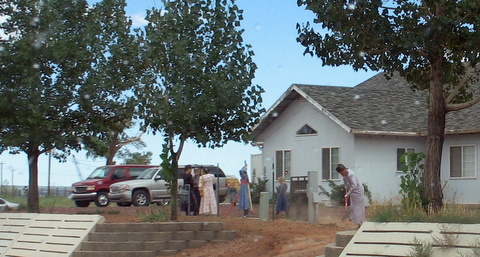
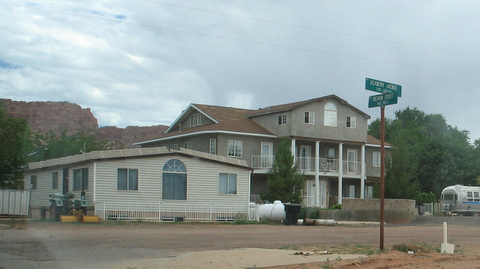
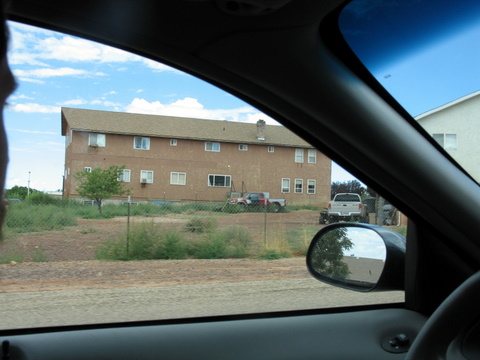
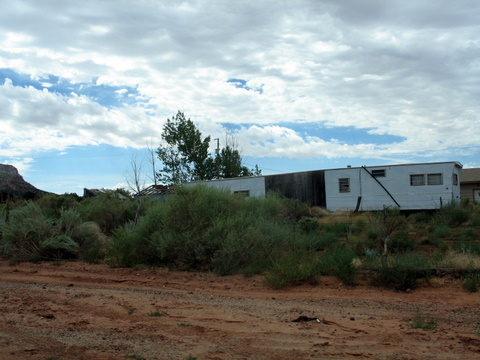
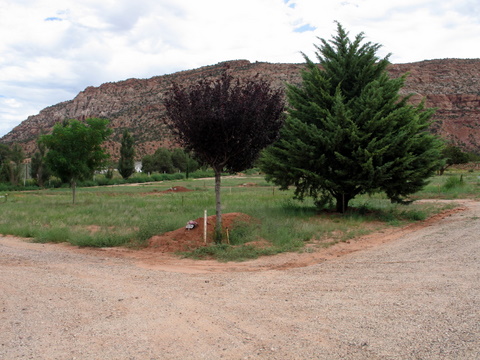
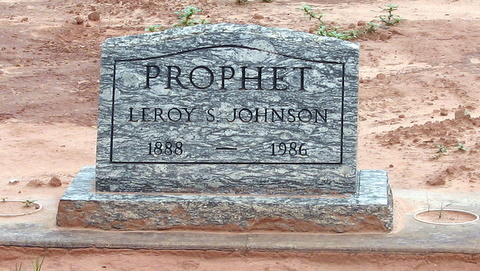
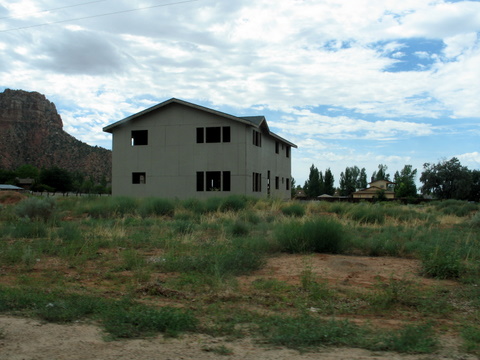
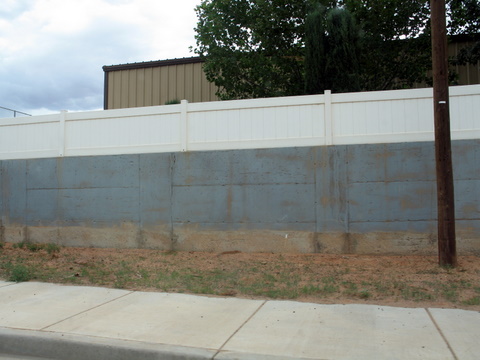
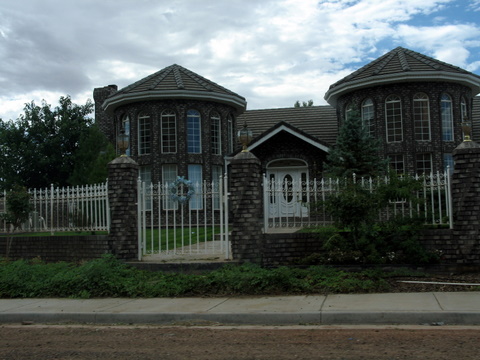
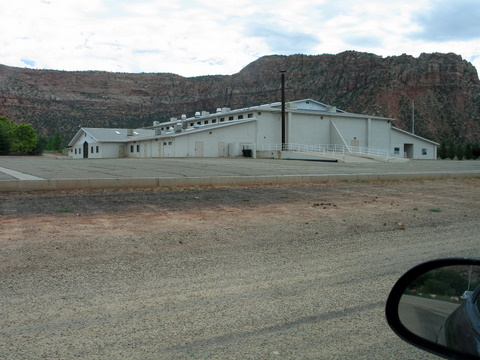
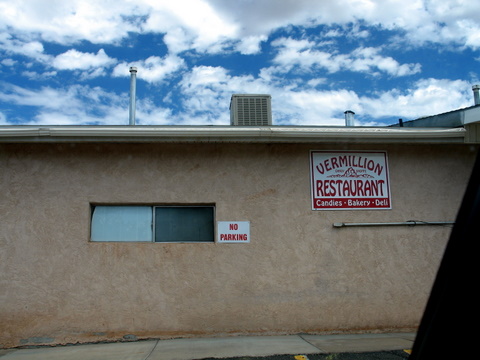
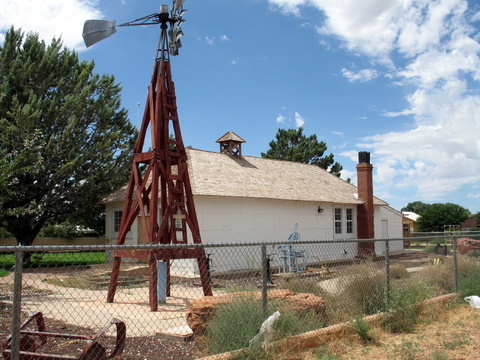
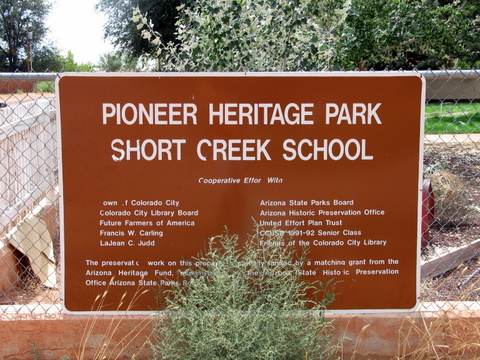
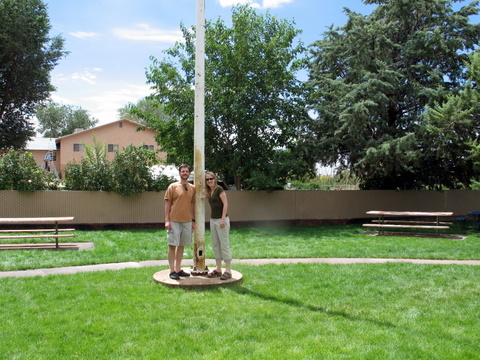
Leave a Reply